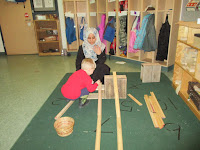Week in Review: April 4th- 8th
Creating windmills using loose parts
 During group time, we discussed various types of windmills and how they move. We provoked the children's thinking with a variety of different materials such as spoons, cups, paper, and toilet paper rolls. Some of the children used the paper towel rolls or cups as a base. Then they attached spoons or strips of paper to the top of the roll to represent the blades. While other children were thinking about how they can represent the blades. They started off by finding a circular lid and then adding to pieces of paper and/or plastic to it.
During group time, we discussed various types of windmills and how they move. We provoked the children's thinking with a variety of different materials such as spoons, cups, paper, and toilet paper rolls. Some of the children used the paper towel rolls or cups as a base. Then they attached spoons or strips of paper to the top of the roll to represent the blades. While other children were thinking about how they can represent the blades. They started off by finding a circular lid and then adding to pieces of paper and/or plastic to it. - Early Learning Expectation: Creativity-Imagination-Visualization. Children demonstrate a growing ability to use originality or vision when approaching learning; use imagination, show ability to visualize a solution or new concept.
- Early Learning Expectation: Initiative-Engagement-Persistence Attentiveness. Children demonstrate the quality of showing interest in learning; pursue learning independently.
- 5. Early Learning Expectation: Reasoning-Problem Solving-Reflection. Children demonstrate a growing capacity to make meaning, using one’s habits of mind to find a solution or figure something out.
- 1.Early Learning Expectation: Observation and Inquiry. Children develop positive attitudes and gain knowledge about science through observation and active play.
- 2. Early Learning Expectation: Living and Non-living Things. Children show a beginning awareness of scientific knowledge related to living and non-living things.
Creating roles for the slats
Last week, the children were working on creating a pathway for the ball using the slats and wooden blocks. Many of the children favored rolling the ball down the ramp and watching as it traveled down the pathway. Many of the children noticed as their ball traveled down the ramp the slats pieces moved away from another resulting in their ball rolling onto the floor. Some children pointed out that the path needed to be longer;therefore, more slats needed to be added. In order for the ball to roll down the path successfully, the children needed to maintain the pathway. During group time, we brainstormed various roles we could take on while exploring the slats and blocks. We came up with a launcher this is a person who releases the ball. A connector a person who connects the two slat pieces together. Lastly, an adder a person who adds more slats to the end of the pathway.
Early Childhood Standards of Quality
3. Early Learning Expectation: Curiosity–Inquiry-Questioning Tinkering-Risk Taking. Children demonstrate an interest and eagerness in seeking information (e.g., be able to see things from a different perspective, fiddling with something to figure it out or attempting a reasonable solution).
5. Early Learning Expectation: Reasoning-Problem Solving-Reflection. Children demonstrate a growing capacity to make meaning, using one’s habits of mind to find a solution or figure something out.
7. Early Learning Expectation: Positive Activity. Children participate in activities that encourage self-motivation, emphasize cooperation, and minimize competition.
3. Early Learning Expectation: Relationships with Others. Children develop healthy relationships with other children and adults.
Painting are self portraits
This week, we focused looking at ourselves. We guided the children's thinking with a mirror, white paper, a paintbrush and a palette with a variety of different skin tones. The children discussed what they saw in the mirror, the paint color that would best represent their skin tone and how they were going to guide their paintbrush. The children enjoyed mixing the various colors together to achieve their skin tone. Also, they thought about where they needed to place the paint circle on their paper.
Early Childhood Standards of Quality
Early Learning Expectation: Visual Arts. Children show how they feel, what they think, and what they are learning through experiences in the visual arts.
1.Early Learning Expectation: Understanding of Self. Children develop and exhibit a healthy sense of self.
6. Early Learning Expectation: Fine Motor Development. Children experience growth in fine motor development and use small muscles to improve a variety of fine motor skills both in structured and unstructured settings










